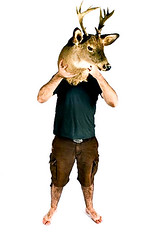I was in the chat room earlier and Auntie's Card Shop mentioned that her husband had taken up screen printing. Like everyone else he was pretty frustrated with the whole deal. That reminded me that half of my intention for this blog was to offer Screenprinting advice. So here is some information on exposure times as I have discovered through trial and error, and a few good websites.
Start off here, where there is a good method to find out how long your screen will take to expose. It's important to remember that your set up needs to be well defined. I haven't built a light box yet because I don't have the money, but if you can build one go for it. If you use the exact same set up every time you'll be able to zero in on the correct exposure time. Not only does the light source matter, but also it's distance from the image. I just have mine set up and I don't change it so that my timing will be consistent. Heat can also be an issue, seeing as heat will set the emulsion as well as light. So you might want to consider having a fan cool off your burning area.
If you've purchased a Diazo Photo Emulsion Kit, you should have an instruction booklet. That booklet is handy. If you want the easy way out, just follow it's instructions exactly. Here is the chart from that booklet. The columns go Screen size, inches image is away from light, and exposure time. These times also assume you are using a tin foil pie plate as a reflector.
for 150 watt
8x10... 12 inches... 45min
10x14.. 12 inches... 45min
16x20.. 17inches... 1hr 32 min
18x20.. 17incesh... 1hr 32 min
for 250 watt BBA no 1 photoflood (this light is a normal looking light bulb, not what you would think of when you hear floodlight)
8x10... 12 inches... 10min
10x14.. 12inches... 10min
12x18.. 15inches... 16min
16x20.. 17inches... 20min
18x20.. 17inches... 20min
The reason the distance increases is to make sure that the light is covering the image evenly, it's not a direct relationship to the size of the screen. I sometimes use a screen much larger than the image I'm burning, so as long as the light covers the image area evenly you'll be fine.
My set up uses a 300 watt unflitered UV lightbulb set up about 24 inches away from my image. It is so far away because I use a pair of chairs to hold up my image, so that I can move my make shift "light box" and as long as I use the same chairs everything is consistent. If I dropped my image to half of it's current setting, 12 inches, it would be easy to figure my new exposure time - simply slice it in half. My screens expose for about 25 minutes.
One thing I have noticed is that my lightbulbs degrade over time. After a few months of use my screens stopped coming out correctly and I couldn't figure it out. I think that the light bulb had lost a little bit of it's power and was taking slightly longer. It was an easy fix, though, as I just added a few minutes and fixed the problem.
So all in all, this information may not be as helpful as you'd like, but it's a start. If you follow that first link and use that method of experimenting, keep your set up consistent, and keep trying you'll figure it out and then it's easy sailing. When and if I ever build my own light box, I'll include some basic instructions and pictures so that you can build your own for more consistent results.
Hope this helps!
Subscribe to:
Post Comments (Atom)



No comments:
Post a Comment